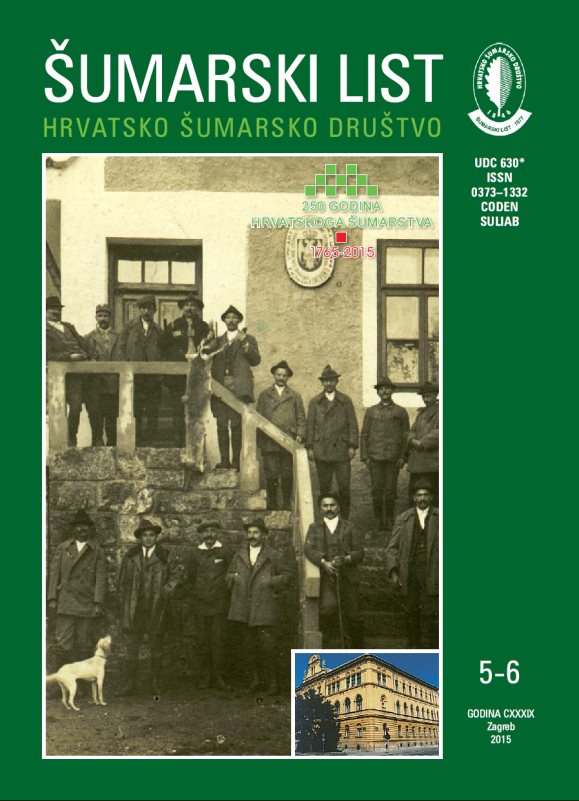
broj: 5-6/2015
pdf (6,02 MB) |
|
||||||||||||||
| RIJEČ UREDNIŠTVA | ||
| Uredništvo | ||
| STATE EXAMS FOR INDEPENDENT MANAGEMENT OF A FOREST ENTERPRISE pdf HR EN | 221 | |
| IZVORNI ZNANSTVENI ČLANCI | ||
| Tamara Jakovljević, Ivana Radojčić Redovniković, Marina Cvjetko, Ivana Bukovac, Marija Sedak, Maja Đokić, Nina Bilandžić | UDK 630*414 (001) | |
| THE POTENTIAL OF POPLAR (Populus nigra var. italica) IN THE PHYTOREMEDIATION OF CADMIUM pdf HR EN | 223 | |
| Summary Phytoremediation is considered a promising, inexpensive and aesthetically acceptable, in situ technology to remediate heavy metals from contaminated soils. The potential use of trees in the phytoremediation of soil has been recognized in the past decades. Thus, the potential of poplar (Populus nigra var. italica) in phytoremediation of cadmium (Cd) was investigated. Aims of this study were to explore the cadmium phytoextraction ability of poplar, the accumulation and distribution of cadmium in different plant parts (leaf, stem, root), the potential role of polyphenolic compounds and the activity of enzyme phenylalanine-ammonium liase (PAL) in response to plant stress caused by the accumulation of different cadmium amounts. During 55 days long growing period soil was treated with different amount of cadmium (w= 10, 25, 50 mg kg–1 soil). The accumulation of cadmium and the distribution in different parts of poplar (leaf, stem, root) were explored (Figure 1). Total cadmium accumulation in plant biomass increased with the increasement in cadmium concentration in soil. Cadmium distribution in poplar decreased in the order: root > stem > leaf. In order to evaluate phytoextraction ability of poplar, the bioaccumulation factor (BF) and the translocation factor (TF) were calculated (Figure 2 and 3). Certain BF values indicate increased accumulation ability of poplar up to 25 mg Cd kg–1 soil (Figure 2). TF values indicate specific tolerance for cadmium concentration up to 10 mg kg–1 soil (Figure 3). Further, in order to evaluate potential of polyphenolic compounds in plant response to stress caused by exposure to different concentration of cadmium, total polyphenol content in poplar leaves was analysed as well as activity of antioxidant enzyme phenylalanine-ammonium liase (PAL). Total polyphenol content in poplar treated with 10 mg Cd kg–1 soil and 25 mg Cd kg–1 soil increased compared to the control (Figure 4). Furthermore, phenylalanine-ammonium liase (PAL) activity increased only in poplar treated with 10 mg Cd kg–1 soil compared to the control (Figure 5). Observed higher total polyphenol content is connected with increased phenylalanine-ammonium liase (PAL) activity and de novo polyphenol synthesis in plant during the stress caused by exposure to cadmium. Results indicate that the tested poplar (Populus nigra var. italica) can be considered as a species with potential for phytoextraction of cadmium from polluted soil. Furthermore, antioxidant enzymes and polyphenolic compounds in poplar have the important role in the defence from oxidative stress caused by exposure to cadmium. Key words: phytoremediation; poplar; cadmium; polyphenolic compounds; enzyme phenylalanine-ammonium liase | ||
| Ivan Martinić, Matija Landekić, Matija Bakarić, Drago Marguš, Anita Jurković | UDK 630*279+41 (001) | |
| VISITOR RISK REDUCING DURING HIKKING IN PROTECTED AREAS BY THE USE OF TAKE A BREAK SCHEME pdf HR EN | 233 | |
| Dijana Čortan,Bojan Tubić, Mirjana Šijačić-Nikolić, Dragan Borota | UDK 630*164 (001) | |
| VARIABILITY OF BLACK POPLAR (Populus nigra L.) LEAF MORPHOLOGY IN VOJVODINA, SERBIA pdf HR EN | 245 | |
| Milorad Danilović, Milan Kosovski, Dragan Gačić, Dušan Stojnić, Slavica Antonić | UDK 630* 462 + 326 (001) | |
| DAMAGE TO RESIDUAL TREES AND REGENERATION DURING FELLING AND TIMBER EXTRACTION IN MIXED AND PURE BEECH STANDS pdf HR EN | 253 | |
| PRETHODNO PRIOPĆENJE | ||
| Sanja Novak Agbaba, Nevenka Ćelepirović, Monika Karija Vlahović, Boris Lović | UDK 630*443 | |
| Eutypella parasitica R.W. Davidson & R.C. Lorenz SEVEN YEARS AFTER THE FIRST FINDINGS IN CROATIA pdf HR EN | 263 | |


